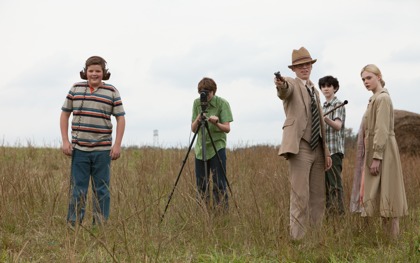Primary navigation

USA 2011

Reviewed by Henry K. Miller
Our synopses give away the plot in full, including surprise twists.
Ohio, 1979. A group of teenage boys - including Joe, who has recently lost his mother in an industrial accident - set out to make an amateur zombie movie. With the slightly older Alice, they are filming one night by the railway when a driver deliberately stops his car on the tracks, causing a massive wreck. The culprit, one of their teachers, tells them not to breathe a word. Soon the town is swarming with US Air Force personnel.
While the teenagers wait for their film - which has captured the crash - to be developed, they shoot new scenes, documenting the various strange phenomena now afflicting the town. They discover that their teacher used to be involved in military experiments on an alien monster - which is glimpsed in their film - and that he derailed the train in order to let it achieve its aim, communicated to him through telepathy, of going home.
The USAF evacuates the town and begins to destroy it in the continuing search for the alien, which has kidnapped Alice among others. The teenagers find the alien in its lair underneath the cemetery, where it is trying to build a spacecraft. Having rescued Alice, Joe communicates telepathically with the creature and convinces it that they mean it no harm. The alien converts the town’s water tower into a rocket and flies away.
Henry K. Miller on expert retromaniac J.J. Abrams’ homage to 1970s backyard filmmaking, “a Spielberg pastiche of uncanny precision and sublime pointlessness.”
At the end of her essay ‘Film and the Radical Aspiration’, published in the autumn of 1966, at the time of the first seasons of Mission: Impossible and Star Trek, Annette Michelson wrote that, “Within the structure of our culture, ten-year-olds are now filming 8mm serials - mostly science fiction, I am told - in their own backyards. This, perhaps, is the single most interesting fact about cinema. Given this new accessibility of the medium, anything can happen.” Steven Spielberg, who had been one of those kids, was then 19; J.J. Abrams, who would become one, had just been born. Among all the interesting things that could have happened, Abrams - whose backyard efforts owed a debt to the maker of Close Encounters of the Third Kind (1977), and who was once entrusted with the job of restoring Spielberg’s teenage reels - went on to direct the third (and best) Mission: Impossible movie before rebooting the Star Trek franchise. Then he made Super 8, a Spielberg pastiche of uncanny precision and sublime pointlessness.
Just as Tarantino’s Kill Bill Vol. 1 (2003) began with the old Shaw Brothers logo, so Super 8 begins with the Amblin Entertainment title-card familiar from Abrams’s obvious models, E.T. (1982) and The Goonies (1985) - but this is no in-joke. Super 8 really is an Amblin picture; Spielberg, credited as a producer, has given it his blessing. An avatar of what music critic Simon Reynolds calls ‘retromania’, Abrams knows his sources so well that, at least on this showing, he has almost nothing of his own to bring to the table.

What makes the case all the more strange is that as producer on the excellent Cloverfield (2007), Abrams helped to introduce a new monster-movie aesthetic using ‘prosumer’ digital video. Super 8 looked set to be both a prequel in narrative terms and a backwards development of the earlier film’s style into analogue home-movie format; but by adopting his mentor’s visual repertoire, Abrams seems perversely to have forsworn the opportunity to start his own franchise.
This alien, a test subject for the US military, just wants to go home; but unlike E.T. it’s not afraid to break a few heads to get there. When it escapes by way of a train crash caused by one of its human sympathisers outside a small town in Ohio, its captors descend on the area, in pursuit also of any witnesses. These include a gang of teenage amateur filmmakers, whose camera has caught a glimpse of the beast before its disappearance and who eventually run it to ground having learnt that, despite all the killing and kidnapping, it has a heart of schmaltz. Unlike the run of ‘just in time’ summer blockbusters, Super 8 is an immaculate production, and set-piece scenes, such as the derailment and a later attack by the alien on a military vehicle, are first rate. The growing mystery around the creature, cause of disappearing dogs and motor engines and people, is effective even if the device of leaving it unseen till late in the film, as in Jaws (1975), is palpably contrived and self-conscious.
Appearing alongside Michael Bay’s militaristic Transformers films (also produced by Spielberg), Super 8, in which the US Air Force, led by a parodically sinister Noah Emmerich, is the real villain, provides a timely reminder that mainstream entertainment movies needn’t wave the flag; and there are a few other hints that Abrams, who was a writer on Bay’s Armageddon (1998), intends a critique of the popcorn status quo. The teenage filmmakers learn from their leading lady Alice (Elle Fanning), in the film’s one outstanding moment, that it isn’t enough to provide thrills, that movies work better if the audience cares about the characters. To the same end Abrams offers up a substantial subplot about bereavement, guilt and family breakdown, all magically resolved by the alien’s departure, and like everything else in the picture strongly reminiscent of Spielberg. Perhaps unconsciously, Super 8 winds up extolling rote manipulation over smash-bang boredom.
Transformers Dark of the Moon reviewed by Kim Newman (July 2011)
Monsters reviewed by Nick Roddick (January 2011)
Serious mischief: Tom Charity on Joe Dante’s four decade-long anarchic streak (October 2010)
Day of the woman: B. Ruby Rich on Kill Bill Vol. 2 (June 2004)
An eye for an eye: Nick James on Steven Spielberg’s Minority Report (August 2002)
American Movie reviewed by Charles Taylor (July 2000)
A.I. Artificial Intelligence reviewed by Philip Strick (October 2001)
Ghost in the machine: Manohla Dargis on Tom Cruise and Mission Impossible 2 (July 2000)